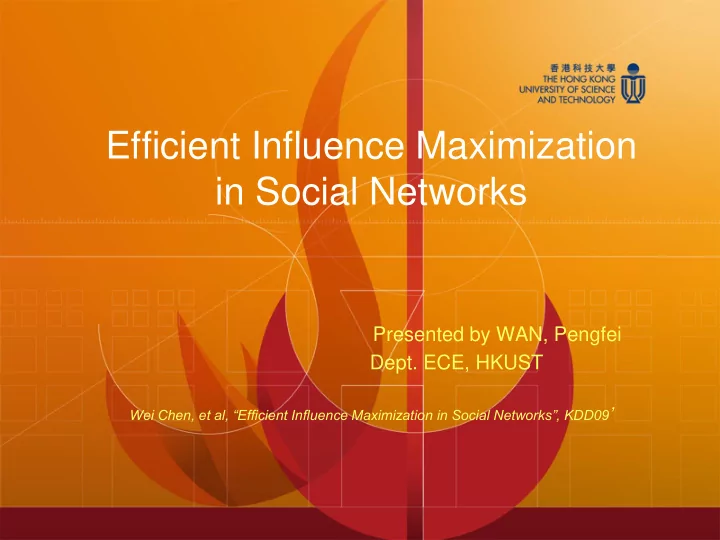

Efficient Influence Maximization in Social Networks Presented by WAN, Pengfei Dept. ECE, HKUST Wei Chen, et al, “Efficient Influence Maximization in Social Networks”, KDD09 ’
OUTLINE • Problem • Previous Work • Degree Discount Heuristics • Summary • References
Problem Statement • Find a small subset of nodes in a social network that could maximize the spread of influences. • Known as Influence Maximization • A.k.a Viral Marketing which makes use of “word -of- mouth marketing” properties of social network
Problem Statement • Optimization problem first introduced by Domingos and Rechardson, KDD01’/02’, NP-hard to solve • Elegant graph formulation introduced by Kempe , et al, KDD03’ Given : A graph G(V, E): --Vertices: individuals in social network --Edges: connection or relationship k, size of output seeds A cascade model: LTM, ICM Output : S, a set of seeds (nodes) that maximize the expected number of nodes active in the end
Problem Statement: Cascade Model • Models how influences propagate • Linear Threshold Model (LTM) • Independent Cascade Model (ICM) • … … • Analogous to Epidemic Models like SIS, SIR
Linear Threshold Model • A node u has random threshold θ u ~ U[0,1] • A node u is influenced by each neighbor v according to a weight b uv witch satisfies: b 1 u v , v neighbor of u • A node u becomes active when at least θ u fraction of its neighbors are active b u v , u v active neighbor of u
Independent Cascade Model • When node u becomes active, it has a single chance of activating each currently inactive neighbor v. • The activation attempt succeeds with probability p uv . • In both LTM and ICM, active nodes never deactivate.
OUTLINE • Problem • Previous Work • Degree Discount Heuristics • Summary • References
Previous Work: “Maximizing the Spread of Influence Through a Social Network”,KDD03’
Previous Work: “Cost - effective Outbreak Detection in Networks”, KDD07’ • Proposed by J. Leskovec, A. Krause, et al • Cost-effective Lazy Forward algorithm: The CELF optimization utilizes submodularity of influence spread function to greatly reduce the number of evaluations of vertices, and get the same performance as the original greedy algorithm. • Submodularity: S T N , v N T \ , f S ( v ) f S ( ) f T ( v ) f T ( ) • Efficiency: approximately 700 times fast than original greedy algorithm, but still hours to finish.
OUTLINE • Problem • Previous Work • Degree Discount Heuristics • Summary • References
Degree Discount Heuristics • Proposed by W.Chen, Y.Wang , S.Yang from MSRA and Tsinghua • High Efficiency: Amazingly reduces the running time by over six orders of magnitude with less than 3.5% degradation in performance. • Motivation: Conventional degree/centrality based heuristics perform poorly in practical scenarios because they ignore the network effect . Important Fact: Since many of the most central nodes may be clustered, targeting all of them is not at all necessary.
Degree Discount Heuristics
Degree Discount Heuristics
Degree Discount Heuristics • Algorithm:
Degree Discount Heuristics • Evaluations on NetHEPT:
Degree Discount Heuristics • Evaluations on NetPHY:
OUTLINE • Problem • Previous Work • Degree Discount Heuristics • Summary • References
Summary • The current influence maximization problem is simplified, without considering other features in social networks, such as community structures and small-world phenomenon. • The author suggests that we should focus our research efforts on searching for more effective heuristics for different influence cascade model in real life influence maximization anpplications • More sophisticated heuristics are promising, such as taking into consideration multiple links between nodes, higher-order influences, cross- neighborhood structure…
OUTLINE • Problem • Previous Work • Degree Discount Heuristics • Summary • References
References • W. Chen, Y. Wang and S. Yang ,“Efficient Influence Maximization in Social Networks”, KDD 2009 • D. Kempe, J. Kleinberg and E. Tardos, “Maximizing the Spread of Influence through a Social Network”, KDD 2003
Thank you !
Recommend
More recommend